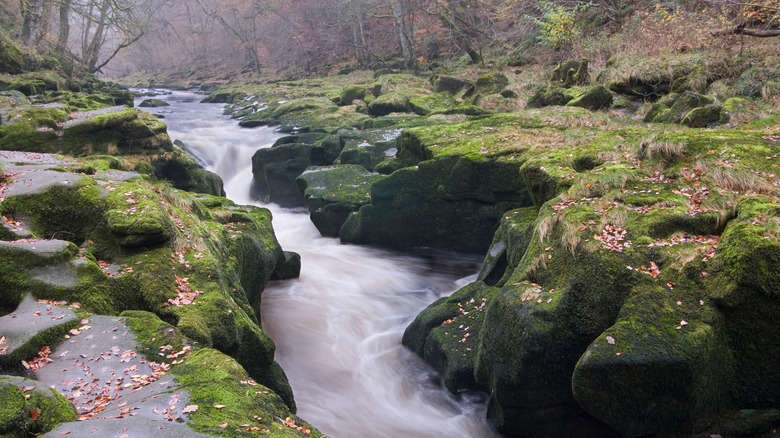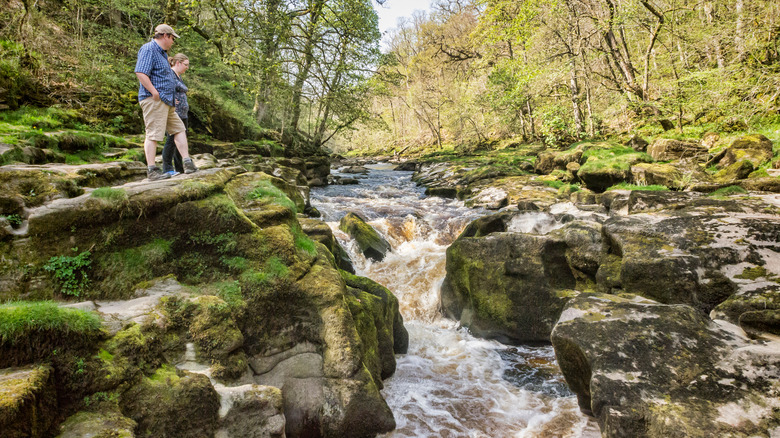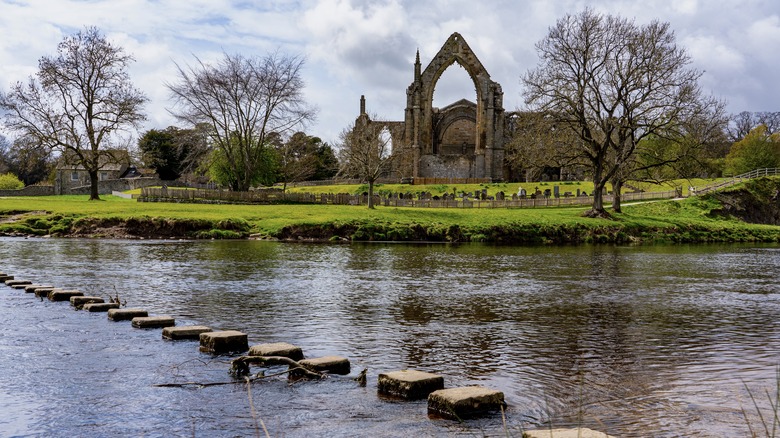The Horrifying Reason This Body Of Water In The UK May Be The Deadliest In The World
The Yorkshire Dales is one of Britain's most beloved national parks, attracting over 8 million visitors each year. It's a haven for hikers and lovers of the outdoors, thanks to its dramatic and diverse landscape featuring everything from craggy peaks to verdant pastures, woodlands, and valleys. The beloved River Wharfe meanders through the heart of the area on its way to one of the park's most picturesque locations, flowing past the romantic ruins of Bolton Abbey. Here, the river is broad and the current is slow, but be on guard — it funnels off nearby into one of the most dangerous vacation spots in the United Kingdom.
Along the opposite bank from the Abbey runs Strid Wood, a peaceful forested area resplendent with bluebells in the spring. It's a popular destination for walkers and nature enthusiasts, but danger lies nearby. Through the heart of the wood is the infamous Strid, a haphazard offshoot of the River Wharfe carved deep into the rock by water forced through a narrow gulley. Flanked by huge mossy boulders and buffeted by torrents of white water, there is no escape for anyone who has the misfortune to tumble in due to misadventure or accident. Although it may not seem that wide or deep, its reputation speaks for itself — the Strid has claimed many lives.
What makes the Strid so dangerous?
The Bolton Strid doesn't look all that menacing at first glance. Surrounded by serene woodland and only measuring around 6 feet across, it's a beautiful spot to rest on a large slab and watch the frothing churn of water through the rocky creek below. Appearances can be deceptive, however, and the small span of the Strid has been known to lull people into a false sense of security in the past, tempting them to venture too close or even attempt to leap across to the other side. No doubt many have succeeded without incident, but red warning signs approaching the Strid lay out the peril in no uncertain terms: "DANGER! The Strid is DANGEROUS and has claimed lives in the past. Please stand well back and beware slippery rocks."
The signs are not overstating the treacherous nature of the Strid. Beyond the strong current that can sweep a person far downstream in a matter of minutes, there are numerous deadly hazards beneath the surface. The chaotic warren of caves torn into the limestone over the centuries create inescapable deathtraps and powerful vortices can pin a person to the jagged creek bed. The danger is still very real even if you do manage to keep your head above water, as the fast flow and heavy turbulence can smash you into the sharp rocks and knock you unconscious.
How many people have died in the Strid?
Although there are no official figures documenting how many people have met their doom in the Strid, local legend follows that no one who has fallen into the water there has ever survived. The oft-quoted 100% fatality rate has gained this beauty spot notoriety all over the world as one of the most dangerous places to swim — intentionally or not.
Without accurate numbers, it is impossible to say whether that is true. However, one thing we do know is that the Strid has claimed lives for centuries, and one of the earliest recorded incidents completely altered the shape of the landscape. One famous myth regards a young lad called William de Romilly who reputedly tried to jump across the Strid during the 12th century, but fell in and died. His grieving mother, Lady Alice de Romilly, gave the surrounding land to Augustine monks so they could build Bolton Abbey and pray for his soul. The incident has been immortalized in poems by Samuel Rogers and William Wordsworth.
The creek has also claimed victims in more recent times. In 1934, an artist named Arthur Reginald Smith vanished while painting nearby and a water diviner helped recover his body. Then, there was the sad case of newlyweds Barry and Lynn Collett, who were swept away by a flash-flood and drowned in 1998. The Strid is a beautiful place, but take heed of the warnings if you want to avoid becoming part of its tragic history.


